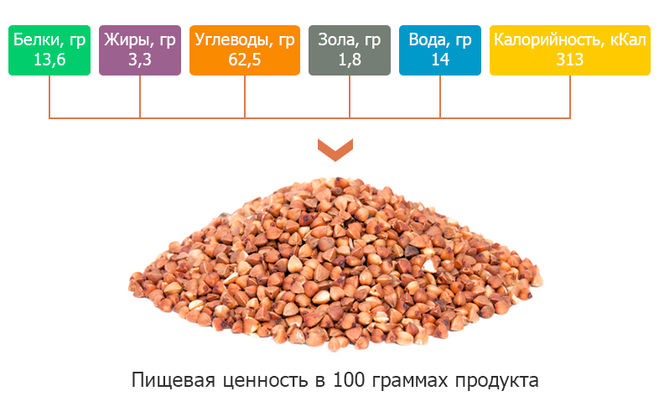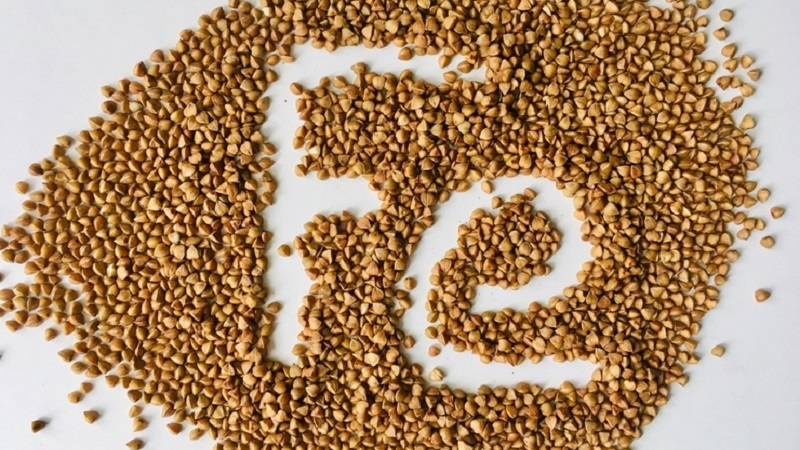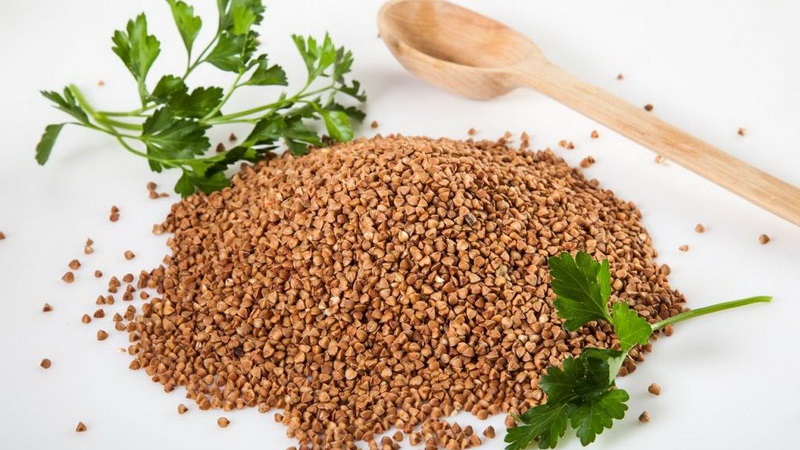Calorie content and nutritional value of buckwheat per 100 grams
Buckwheat has two beneficial properties: nutritional value and moderate calorie content. In terms of protein content, it is considered the leader among all cereals, and in nutritional value it is second only to oatmeal. Therefore, buckwheat dishes are useful for people involved in sports and leading an active lifestyle. From this article you will find out how many calories are in 100 grams of buckwheat and what valuable substances it contains.
The content of the article
Calorie content and nutritional value of buckwheat per 100 g

There are three types of dry buckwheat groats: unground, done and flakes... Kernels are whole grains, peeled from the husk, and are most often used to make crumbly cereals. Prodel, otherwise called a chop - crushed and chopped groats. Dishes from it are softer and more homogeneous. Flakes are more suitable for children's menus and nutrition for the elderly.
The calorie content of the kernel is higher than that of the limit and flakes, and ranges from 305 to 350 kcal. It depends on the quality of the grain and the type of cereal. For the characteristics, we will use the average.
Reference. The calorie content of dry buckwheat is 313 kcal per 100 g. The content of proteins is 12.6 g, carbohydrates - 62.1 g, fats - 3.3 g.
The nutritional value of cereals changes during the cooking process. When boiled, it swells about three times, respectively, and the calorie content is distributed over 300 g of the finished product. The more water you take for cooking, the lower the calorie content of 100 g of porridge will be.
Reference. The calorie content of boiled buckwheat when using 200 ml of water and 100 g of cereals is 104 kcal per 100 g of the finished product. BJU cooked cereals: proteins - 4.2 g, carbohydrates - 20.7 g and fats - 1.1 g
The energy value of a dish increases if it is cooked with milk and butter. Salt does not affect calorie content.
When cooking the amount of fiber is almost three times reduced, and vitamins remain in a minimum volume. To preserve the nutrients, it is recommended to steam the buckwheat with boiling water. To do this, it is necessary to rinse the cereals and fill them with hot water overnight, for example, in a thermos.
Reference. The calorie content of steamed buckwheat when using 300 ml of water per 100 g of cereal is 78.3 kcal per 100 g of the finished product. Protein content - 3.2 g, carbohydrates - 15.5 g and fat - 0.8 g.
Buckwheat suitable for diet food. It does not contain simple carbohydrates that contribute to the appearance of excess weight. Its complex carbohydrates release energy gradually during digestion. Thanks to this, the feeling of hunger does not arise for a long time.
Buckwheat is considered the leader in protein content among cereals. 100 g of ready-made porridge accounts for 5.6% of the daily human need. Proteins are highly digestible, which makes this cereal indispensable in the diet of athletes for the development of muscle mass.
Porridge contains a minimum amount of fat - only 1.3% of the daily value. There are no harmful saturated fats at all.
The high fiber content (about 10.5%) helps buckwheat to effectively cleanse the body, contributing to the normalization of digestion.
Buckwheat is not considered a cereal crop, as it is a buckwheat flower seed. Therefore, buckwheat protein, unlike wheat, does not contain food allergy causing gluten.
The composition of cereals

The content of vitamins in buckwheat is within the range typical for cereals. Groats are rich in B vitamins, which, when taken together, enhance each other's action. These vitamins do not accumulate in the body and must be supplied daily.
By the amount of B1, cereals are ahead of many other products of plant origin.The main function of B vitamins is to maintain the normal functioning of the nervous and immune systems.
| Name | The amount of mg in 100 g of dry product | % of the daily value |
| Vitamin B1 | 0,43 | 28,7 |
| Vitamin B2 | 0,2 | 11,1 |
| Vitamin B6 | 0,4 | 20 |
| Vitamin B9 | 0,032 | 8 |
| Vitamin PP | 7,2 | 36 |
| Vitamin A | 0,002 | 0,2 |
| Vitamin E | 0,8 | 5,3 |
Buckwheat contains the maximum amount of vitamin PP in comparison with other cereals... With its use, blood circulation processes improve, blood vessels expand, the body is cleansed of toxins.
The set of micro and macro elements in cereals is also diverse. Due to the high content of magnesium, metabolism is normalized, sugar level is regulated. Sodium, potassium and silicon maintain the water-salt balance in the body. High iron levels prevent anemia. And phosphorus, like calcium, affects the formation of the bone skeleton.

| Name | The amount of mg in 100 g of dry product | % of the daily value |
| Macronutrients | ||
| Potassium | 380 | 15,2 |
| Calcium | 20 | 2 |
| Sodium | 3 | 0,2 |
| Magnesium | 200 | 50 |
| Phosphorus | 298 | 37,3 |
| Silicon | 81 | 270 |
| Trace elements | ||
| Iron | 6,7 | 37,2 |
| Zinc | 2,05 | 17,1 |
| Iodine | 0,003 | 2,2 |
| Copper | 0,64 | 64 |
| Manganese | 0,156 | 78 |
| Chromium | 0,004 | 8 |
| Cobalt | 0,003 | 31 |
| Molybdenum | 0,034 | 49,1 |
Buckwheat protein, in contrast to the protein of other cereals, contains non-plant amino acids. This composition is found in meat and dairy products. Groats contain three of the eight essential amino acids for metabolism: lysine, threonine and tryptophan.
Lysine is involved in the formation of collagen, which repairs damaged body tissues. Deficiency of this amino acid leads to weakness, fatigue, and a decrease in muscle mass. Threonine is essential for maintaining muscle function. Tryptophan is used to synthesize the "joy hormone" serotonin, and its deficiency leads to depressive disorders.
Buckwheat also contains essential amino acids. The body cannot synthesize them on its own, but receives only from food. These include valine and isoleucine. The valine content of buckwheat has a calming effect, reduces insomnia and nervousness. Isoleucine normalizes blood sugar levels, improves endurance and accelerates muscle growth.
Conclusion
The content of macro- and microelements, amino acids and B vitamins allows buckwheat to be used in therapeutic diets for anemia, diabetes, obesity. And the high content of protein and complex carbohydrates helps athletes and people who lead an active lifestyle to maintain muscle shape.